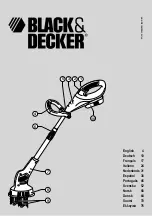
Allow the engine to warm up for several
seconds. If engine either fails to start or
to continue running, push in primer bulb
two (2) times. Grasp starter rope and
pull with a rapid, full stroke, up to ten
(10) times.
TROUBLESHOOTING: Push the primer
bulb in two (2) more times. Using a rapid
full stroke, pull out the starting rope up to
ten (10) times. If engine still does not
start, wait 15 minutes. Do not prime
engine further. Grasp start rope and pull
with a rapid, full stroke up to ten (10)
times.
TILLING AND CULTIVATING
Use your machine to break up sod, pre-
pare seedbeds and for cultivating in gar-
dens and flower beds. It is easy to
operate, but it is important that you start
out slowly and read this Section thor-
oughly before putting it to use. Let the
machine do most of the work. The tines
will pull the machine forward, letting you
adjust forward speed by pressing down
or lifting the handlebars.
1. Roll the machine to the work area.
2. Adjust the tilling depth to the desired
position (see Pre-Start Preparation, pre-
vious page).
3. Start the engine (see Stopping and
Starting the Engine, previous page).
Stand behind the handlebar and push
down on the bar to raise the tines off the
ground. Squeeze the Throttle/Tines
Lever– the engine should speed up and
the tines start rotating. Release the
Throttle/Tines Lever to return to idle, the
tines should stop rotating or they may
rotate very slowly. Lowering them back
to the ground should stop any rotation.
NOTE: If tines continue to rotate when
engine is idling, either the idle speed is
too high or the centrifugal clutch is mal-
functioning. If this occurs, contact the
Factory or your local authorized dealer.
4. Squeeze the Throttle/Tines Lever to
start the tines rotating. Lower the tines to
begin tilling. Firmly hold the handlebar to
prevent the machine from moving for-
ward too quickly and to allow enough
time for the tines to dig deeply enough.
Adjust engine speed to suit the tilling
conditions. Remember that the rotating
tines help to pull the machine forward.
Use slower speeds and a shallow depth
setting when learning to use the unit and
whenever you are tilling on hard, rough or
uneven ground.
5. Do not try to till too deeply in the first
pass through sod or very hard ground. If
the machine jumps or bucks, use a shal-
lower depth setting and reduce the engine
speed. With each successive pass, till
more deeply.
6. Apply downward pressure on the han-
dlebars for shallower tilling. Lift the han-
dlebars to dig more deeply. If the
machine stays and tills in one spot, try
swinging the handlebars from side to side
to start it moving forward again.
7. For easier tilling, water very hard soil a
few days before tilling. Avoid working the
soil when soggy or wet. Wait a day or
two after heavy rain for the ground to dry.
Cultivating
1. Cultivating is shallow tilling that dis-
rupts weeds and aerates the upper crust
of soil.
2. Do not till deeper than 1"-2" to avoid
injuring nearby plant roots. Cultivate
often, so that weeds do not grow large
and cause needless tangling in the tines.
3. With careful planning, you can space
the seed rows far enough apart to allow
sufficient room for the machine to culti-
vate after the plants have grown.
Adjusting Tine Positions
Depending upon the tilling project, you
have a choice of three tine patterns:
Wide (Standard) Tine Positions – As
shipped from the factory, the unit is set
up for general tilling and cultivating. This
10" wide tine pattern (the maximum tilling
width) uses all four tine sections
(A, Figure 9). See Tine Removal and
Installation in Section 5 for detailed infor-
mation on how to set up this tine position.
Narrow Tine Positions – For a narrow,
4-1/2" tilling width, remove the outside
tine section on the left- and right-sides
(B, Figure 9). See Tine Removal and
Installation in Section 5 for detailed infor-
mation on how to set up this tine position.
Stony Soil Tine Positions – When tilling
deeply in stony soil, stones may become
jammed between the inner tines and the
machine hood. This setup swaps the two
inner tines to minimize jamming (C,
Figure 9). See Tine Removal and Installa-
tion in Section 5 for detailed information
on how to set up this tine position.
Section 4: Operation
Figure 9: “A” - all four tine gangs in standard position; “B” - two outer gangs removed for narrow tilling; “C” - the two inner gangs have
been swapped for stony tilling conditions.
A
B
C
9
Keep away from rotating tines. Rotating
tines will cause serious personal injury.
WARNING
Summary of Contents for Garden way 12215
Page 19: ...Notes ...






































